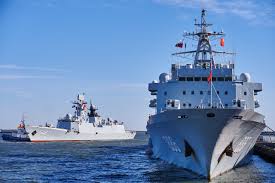The term “Indo-Pacific” has rattled the Chinese security establishment and the state funded think tanks to no end. Almost every discussion there revolves around IPS (the acronym for “India Pacific Strategy” in China). This being the situation, it would be interesting to understand their views on this initiative by the United States.
The world’s attention has been drawn towards the Indian and the Pacific Oceans because of their economic relevance and geopolitical significance. The US, Japan, India and Australia have increased their naval cooperation to secure the sea-lanes of communication over these oceans. It is in this context that the Chinese have proposed the China Pakistan Economic Corridor (CPEC) and the China Myanmar Economic Corridor (CMEC). The Chinese believe that these two form the pillars of its expansionist designs in these oceans and littorals—something that has been furthered by the Belt and Road Initiative (BRI). Although in Chinese writings, it has been stressed often that the BRI is an economic endeavour, but the regional countries view China developing ports, communication, etc., for logistical support for eventually turning them into tools for power projection. In Chinese opinion, the US push for IPS is primarily to offer a beneficial alternative to the region’s countries, in a sense it is a counter to the BRI. The revival of Quad and the passage of the Asia Reassurance Initiative Act (ARIA) into law by the US for developing a long-term strategic vision and a comprehensive, multifaceted and principled US policy for the Indo Pacific Region and for other purposes is a counter to BRI.
Beijing has also assessed that China’s diplomatic outreach and political influence in the region is being perceived by regional countries such as Japan, India and Australia as power imbalance and therefore their coming together for IPS or Quad. However, since IPS is being perceived differently by partner countries, this has resulted in its slow progress.
The majority of think tanks in China are of the opinion that Indo Pacific Strategy will adversely affect China’s economic, military and strategic interests, particularly the BRI and therefore Chinese countermeasures are compulsory.
The Chinese believe that India has not adjusted to China’s inroads into the Indian Ocean since it considers itself to be the leader of the Indian Ocean. Though the Chinese have refrained from the nomenclature “Strategic Autonomy”, for India it regularly says that India does not like to be dictated by any other country in its backyard. China believes this is because of the “Raj Legacy” of the colonial British. China doesn’t take into account the maritime combat power that India has developed over the years. Of course the possibility is there that such statements are directed at China’s domestic audience. China also projects ASEAN as a benign conglomeration of countries that tend to broker a stable balance of power by means of bilateral and multilateral engagements.
In fact, China foresees two challenges in the Indo-Pacific region:
1. The US preventing China from obtaining absolute power in the Indo Pacific region including in the South China Sea and IOR. Permitting China would lead to China enjoying overwhelming advantages on maritime issues, domination on regional economic development and any discourse on regional security and rules of the road for economic activities (obviously, it does not imagine that India has the might to prevent it from doing so).
2. IPS permits the US to maintain control of the sea lines of communication (SLOCs) and the regional economic agenda. The US is heading towards creating a quadrilateral security mechanism in order to deal with the possibility of China gaining overwhelming military advantage and excluding the US from the building of a regional economic and security order.
The second challenge in reality expresses the Chinese desire to form a regional economic and security architecture in the Indo Pacific and more specifically the Indian Ocean Region when it perceives military superiority over the US and India combined. Chinese think tanks often refer to China’s “Military Strategy” paper of 2015, which states that China will secure the trade routes internationally by deploying and basing its navy, the People’s Liberation Army Navy (PLAN0. China’s economic interests need to be protected overseas.
This must ring alarm bells in US and India in particular. While ASEAN would not take any sides, in effect it would be supportive of China. Sri Lanka may use its neutrality hedging and permit Chinese warships transit on the pretext of security of the SLOCS. In the west China has Pakistan and possibly some African peninsular countries which are by and large dependent on it.
Possibly, the time has come to put in place an architecture in the IOR and the larger Indo-Pacific to ensure free and open trade routes, overflights and rule based order as they exist. Any delay could make democracies stare at a fait accompli.
Vice Admiral Shekhar Sinha is Member, Trustee Board, India Foundation and Governing Council Sunday Guardian Foundation, ICWA, IDSA, USI and PPF.
China’s sabre-rattling on Indo-Pacific is alarming
- Advertisement -

